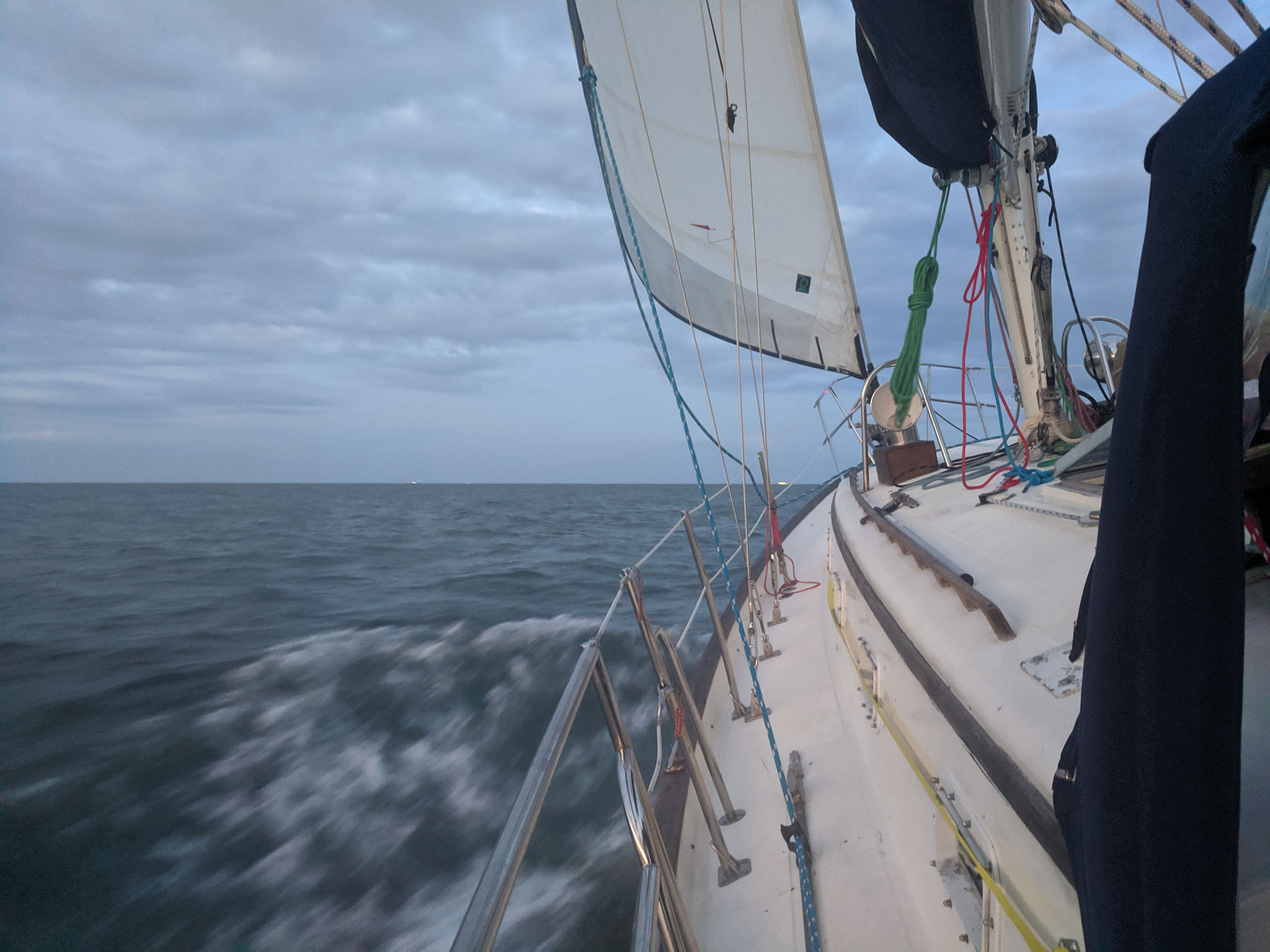After Harvest Moon, we had to get the boat back home. All of our crew had left so it was down to just Shannon and I to make the passage. There are two main options. One, go back offshore and sail all the way back, or two, take the Intracoastal Waterway. With our recent success, I was a big fan of taking option one, but the the weather had driven up the waves quite a bit and it would not have been a comfortable trip. Taking the “ditch” as its called though wasn’t all that exciting either. It would mean running our engine for nearly the whole trip. Even with as well as it handled the trip to the start line, and the major push to the dock after the finish, I was not looking forward to nearly 40 hours of running it home.
The more we talked to our friends and other racers, it became clear that the only real option was the ICW. The waves and wind were just not right for an offshore passage home, and we didn’t have the 2 days to wait for it to clear. So, at sunrise Sunday morning, we fired up Nymeria and started the slow, 5 knot parade back to Galveston.

The first 8 hours and 40 miles or so went quite well. We had been buddy sailing with a friend and kept in contact throughout the trip. Watched as the swampy terrain would change the farther north we got, and generally settled into a fairly relaxing trip. As we continued our way up we started making plans for the rest of the passage. We did not want to motor overnight in the ICW so we needed to get somewhere we could dock up, or anchor. The spot most people recommenced was Port O’Conner, in Matagorda Bay. We were pretty sure we could get there by dark, so that was our goal. There were rumors of a marina, and some info on other places to tie up, but never enough to really get a good sense. Our fallback was just anchor out somewhere in Matagorda bay.
About two hours before we get to Port O’Conner, I start to see our engine temperature start to fluctuate. Given our history with the engine temps and coolant system, I watch that gauge pretty closely. I check the engine bay, and listen closely. Nothing seems out of the ordinary. Engine is running just fine as far as I can tell. After another 20-30 minutes the gauge starts to slowly drop. Now I’m starting to get concerned.
Again, I make my rounds and nothing seems wrong. just the gauge is slowly dropping. In my gut I cannot think of what could cause that. Is the thermostat we just put in stuck open? If there was a real problem the temp would be rising, right? I grab my IR temp gun and physically test the engine. 191 degrees. Maybe a little high, but not really out of range either. Especially since the engine has pretty much run at a good cruise for almost 9 hours at this point.
Still, I’m a bit worried so I call my buddy Blake that has helped me many times in the past with this engine. I explain what I’m seeing and he says, “if its not boiling over, and not making noises I’m probably fine and its just the gauge”. When we get back he will help me replace the sender and gauge. This calms me a but, but with at least an hour until we can stop anywhere, and another 100 or so miles to go, I’m far from OK. About an hour further, and me manually checking engine temps every few minutes we make it to Matagorda bay, find our friends, and set anchor for the night.

This was the first use of our new windlass, and new 45lb Mantus anchor. This thing is a beas. Nearly the instant it hits the bottom and we reverse on it slowly, it sets like a rock. We’ve set a few anchors on Nymeria before, but never have we felt as comfortable about it. We settled in, made some dinner, had a beer, and rightly relaxed for a bit before we slept for the night.
The next morning we got up and set off right at dawn. We had decided that the ditch was boring, and we had hoped that the waves had calmed enough that we could go offshore and sail the rest of the way home. We slipped though the Matagorda channel, and were back in the gulf. There wasn’t much wind, and the waves were moderate, but the engine was running well and we were making progress, so we set our course and motored on.
It was another uneventful day. The engine temp gauge now just read 0 the whole time so I just got into a habit of manually checking the temperature from time to time. We attempted to get the autopilot working, but its an old device and really needs some more configuration and learning NOT in the middle of the gulf for us to get it setup correctly (or just buy an new one). In the end, we had made the plan that if we make Freeport early enough to get to a dock before dark, we would treat ourselves with a slip for the night, but if not we would just continue sailing overnight and reach the Galveston jetties sometime early the next morning.
Turns out Nymeria isn’t fast under motor, and the sun set just as we could see Freeport on the horizon. Luckily though, the wind ha started to pick up, and just after sunset, we were able to raise our sails and shut down the motor. Now were moving 6 knots instead of 5! As we approach the Freeport channel, I’m watching AIS and looking out for lights of any ships coming in or out of the channel. We really don’t want to be in their way. The way looks clear so we sail right in. Just as we get about half way through the channel, I look to the left and see a massive tanker headed directly toward us at probably 14 or so knots. We’re fairly sure we’re far enough through and will make it out of the way in time, but its quite a wake up call. No matter how much you think you are paying attention, something will still surprise you.

We are now on our first “solo” overnight passage. The way is clear between Freeport and Galveston so we continue on into the night. Sailing at night is its own experience. Sailing at night when you are the only one awake, is another all together. Time does something weird, It feels slow, but also fast. I found myself exploring the stars, feeling the boat move, feeling the wind pull us, and really just enjoying the calm that existed in that moment.
We approach Galveston just before dawn. The prudent thing to do would be to wait until sunrise before attempting to head into the channel and through Bolivar roads (one of the busiest shipping intersections int he world). But, we’re tired, and it looks calm and clear enough on AIS and from what we can see so we decide to take the risk. We make sure our radios are on the correct channels pull up and extra device with more AIS info on it, grab the binoculars, and head in. There are a few big ships moving, but most are anchored. We are small enough, and the water is deep enough that we can stay out of the main channel for most of the Galveston area so we make it some way in with no issues.
BBBBWWWWWAAAAAAAAHHHHHH!
That’s the horn of one of the Galveston ferries as it makes its way across to Bolivar, I had noted him earlier, and assumed that if he kept course, we would be well ahead of him by the time he got to us. Unfortunately, he had cut the corner, as ferry drivers tend to do, and was now on a direct collision course with us. Many things go though our heads at this moment (hopefully not a ferry). It seems as though he has plenty of room to go behind us, and it would be easy enough for him to do but this is ferry territory, they don’t GAF. We cranked Nymeria hard over, and and spun one circle as he passed by ahead of us. This has our nerves all up as we push further toward the end of the intersections.
The sun is starting to com up, so its getting easier to see now. There is a freighter coming in behind us that gives us a call on the radio “Sailboat at marker 62” he calls,
“This is the sailboat at 62.”
“What are your intentions, I’m heading into the Houston Ship channel and will be on you in 5 minutes.”
“We are heading that way as well but will maintain our course outside the channel on the green side”
“Ok, see ya on the one, thank you”
We may not have used the right terms, but that’s how communication is supposed to work. The ship passed us with no issues and there were no surprises. Now if only the ferry driver had been so polite. (but again, don’t fuck with the ferries)

Now that we had passed the worst of it, we entered Galveston Bay. The water was glass, and we had a clear 6 hour channel drive home. Except for one tanker.
Those big tankers are quite well designed. When fully loaded and moving at speed, they are pretty efficient, and don’t produce a ton of wake. If they are empty and moving slow, its the same. We passed several in these states and roll over their wake with ease. But then one came by, empty, at speed. Its wake was massive. So big in-fact that when we went though it, we literally went THROUGH it. As we came down off the first wave, the second hit our bow about 2 feet over the top of it and slammed water all the way back to the cockpit over the boat. Now, this was a calm motor, the weather was great, and we were almost home, so we had the Nymeria all opened up and airing out. This meant water went pouring into every open hatch.
With that reminder that we aren’t home yet, we finish the last hour back to our slip. We raise our first place flag, down a bottle of celebratory champagne, and promptly get a hotel room. We left the boat as it was, checked into the Kemah Boardwalk hotel, then had a burger and few strong beverages. We had been up for nearly 36 hours so we though we would take a nap, then get up and have some fun around Kemah that evening. Turns out we were tired, and once we fell asleep we slept from 2 PM to 9 AM the next morning.










One Comment
Comments are closed.